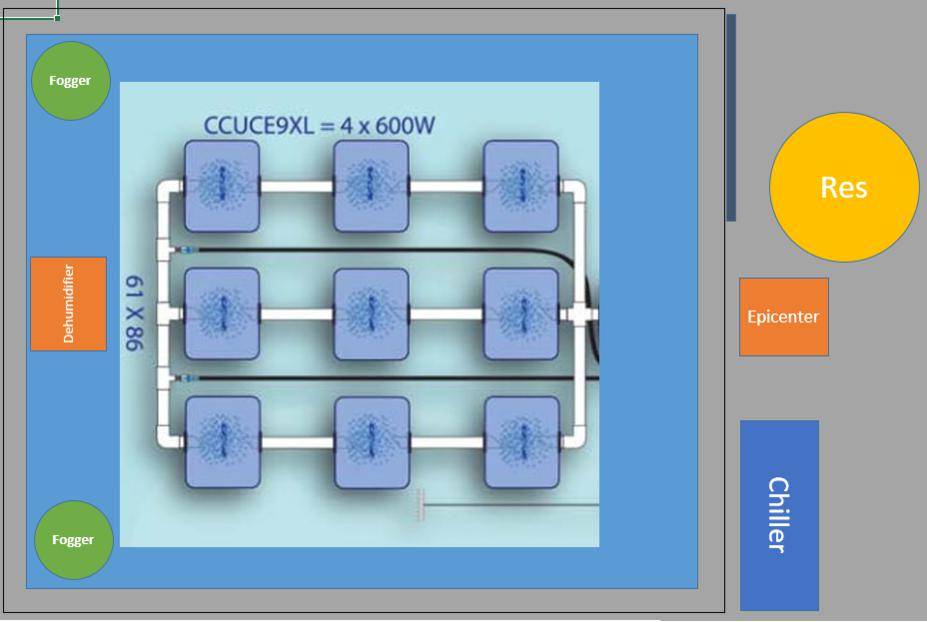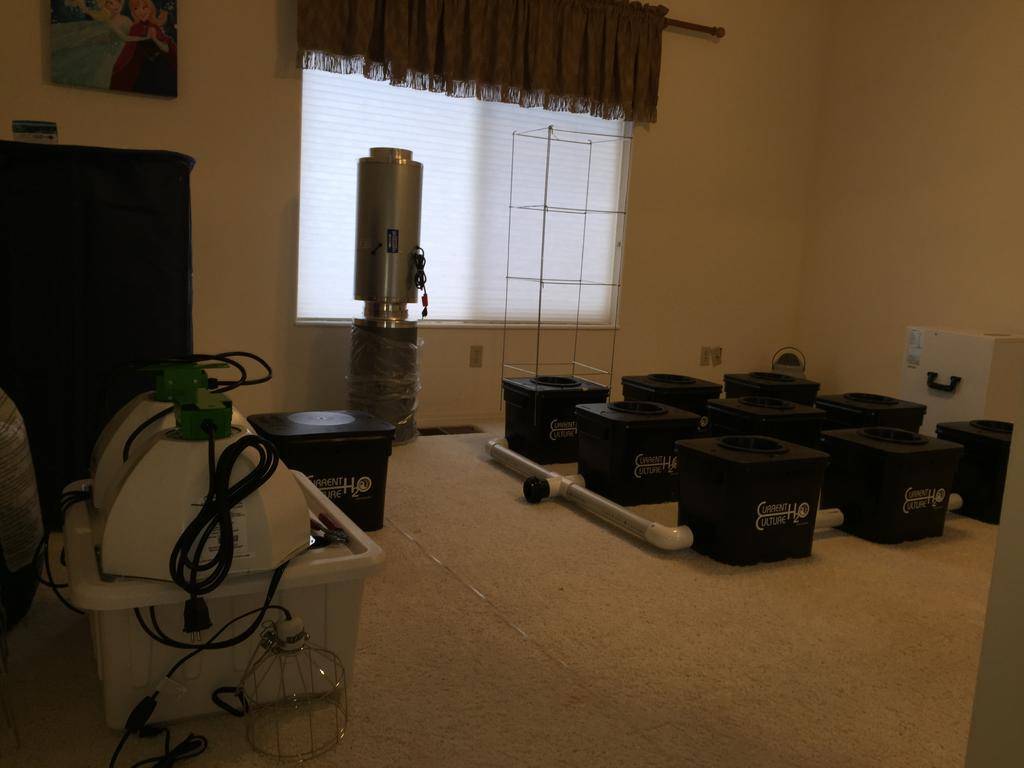I’m just finishing putting together my new setup and wanted to document the maiden voyage. I still have quite a bit to do to get the room ready and I have some upcoming travel so I won’t kick off the grow until late Feb. For now, I’ll document putting the room together and then log the grow.
The plan is to grow out from seed 9 feminized Malawi to find a keeper. I’ve spent about 2 years cruising the forums and reading cannabis cultivation books trying to come up with an ideal CEA (Controlled Environment Agriculture) room. What you see below is a culmination of this research. Thanks to dubi for putting up with my incessant stream of questions!
Equipment List
The Room
10’ x 9’ x 8 ½’ Eden Grow Room with Orca Grow Film throughout
Lighting
(16) Cycloptics Greenbeams – Phillips 4200k
(1) Far Red Flower-Initiator 20 Watt Grow Light
(2) A/B-C DEEP BLUE Booster 50 Watt LED Grow Light
(4) Mega-Ray 275 Watt Self-Ballasted Flood UVB Lamp
Hydroponics
Under Current E9XL with remote epicenter
EcoPlus Water Chiller - 1/2 HP
O2 Grow’s oxygenation system (electrolysis)
Supreme Clarifier UV Sterlizer - 40 watt
Environment / Process Monitoring
Mitsubishi 24,000 BTU Ductless Mini-Split Heat Pump
Active Air Commercial 100 Pint Dehumidifier
Minifogger Humidifier
Titan Controls CO2 Regulator
Hyper Fan Stealth 8 in 710 CFM
Phresh Filter 8 inch x 24 inch 750 CFM
AgrowTek GC-Pro Control System with Indoor Climate + CO2 and pH/EC/Temp/Dissolved O2 Kit
Nutes
Hydroponic Research’s Veg + Bloom RO/Soft version
Hydroponic Research's +Size
Cultured Solutions Roots
The room is a sealed design with primary lighting using Cycloptics Greenbeam CMH lights to deliver about 1,150 μmoles PPFD at about 20” from the fixtures. The walls and ceiling will be covered in Orca. I’m going veg and flower in this room. Secondary lighting includes a far red light to shorten the flower cycle, blue LEDs to keep internode spacing short when using far red and to induce stomatal opening at the beginning of the light cycle, and mercury vapor lamps to provide UVB for enhanced potency.
I plan on running much of the Ace catalog one variety at a time to select keepers. Besides Ace I plan on some selections from Cannabiogen as well as Mandala. With the exception of Bangi Haze and Nep Jam, I’ll focus on non-hybridized sativas and a few non-hybridized indicas. May run commercial cuts at some point further down the line.
First, a quick note regarding the UC. It’s going to run without the standard air pump and micro pore diffusers. Instead I’m using O2 Grow’s electrolysis device to generate oxygen. The Agrowtek has a dissolved O2 (DO) sensor that will control the O2 grow based on DO set point. O2 Grow claims that you can super saturate the UC system which enhances yields. We’ll see. In any case, I’ll be glad to get rid of the air pumps and diffusers. This should help keep pythium and root rot in general at bay. Also going to UV the RO water.
This should be a wild ride so here goes! First question. How long should I veg? Current Culture recommends 2 weeks, but I’m wondering if that is too long for these sativas especially considering the 8 foot ceilings.
Related to this I’m looking for opinions about growing techniques like main lining, Uncle Ben’s Topping Technique, or scrog, or? In such a tight space I’m thinking that scrog is a pain in the ass. The other two methods seem like they are probably easy after in the initial training/topping.
Here’s a cheesy floor plan and a pic of a mock-up of the room. The actual room is still being built, but mocking it up let me finish my planning. I'll post up more details as the room comes together. For now I'm open to all feedback.


The plan is to grow out from seed 9 feminized Malawi to find a keeper. I’ve spent about 2 years cruising the forums and reading cannabis cultivation books trying to come up with an ideal CEA (Controlled Environment Agriculture) room. What you see below is a culmination of this research. Thanks to dubi for putting up with my incessant stream of questions!
Equipment List
The Room
10’ x 9’ x 8 ½’ Eden Grow Room with Orca Grow Film throughout
Lighting
(16) Cycloptics Greenbeams – Phillips 4200k
(1) Far Red Flower-Initiator 20 Watt Grow Light
(2) A/B-C DEEP BLUE Booster 50 Watt LED Grow Light
(4) Mega-Ray 275 Watt Self-Ballasted Flood UVB Lamp
Hydroponics
Under Current E9XL with remote epicenter
EcoPlus Water Chiller - 1/2 HP
O2 Grow’s oxygenation system (electrolysis)
Supreme Clarifier UV Sterlizer - 40 watt
Environment / Process Monitoring
Mitsubishi 24,000 BTU Ductless Mini-Split Heat Pump
Active Air Commercial 100 Pint Dehumidifier
Minifogger Humidifier
Titan Controls CO2 Regulator
Hyper Fan Stealth 8 in 710 CFM
Phresh Filter 8 inch x 24 inch 750 CFM
AgrowTek GC-Pro Control System with Indoor Climate + CO2 and pH/EC/Temp/Dissolved O2 Kit
Nutes
Hydroponic Research’s Veg + Bloom RO/Soft version
Hydroponic Research's +Size
Cultured Solutions Roots
The room is a sealed design with primary lighting using Cycloptics Greenbeam CMH lights to deliver about 1,150 μmoles PPFD at about 20” from the fixtures. The walls and ceiling will be covered in Orca. I’m going veg and flower in this room. Secondary lighting includes a far red light to shorten the flower cycle, blue LEDs to keep internode spacing short when using far red and to induce stomatal opening at the beginning of the light cycle, and mercury vapor lamps to provide UVB for enhanced potency.
I plan on running much of the Ace catalog one variety at a time to select keepers. Besides Ace I plan on some selections from Cannabiogen as well as Mandala. With the exception of Bangi Haze and Nep Jam, I’ll focus on non-hybridized sativas and a few non-hybridized indicas. May run commercial cuts at some point further down the line.
First, a quick note regarding the UC. It’s going to run without the standard air pump and micro pore diffusers. Instead I’m using O2 Grow’s electrolysis device to generate oxygen. The Agrowtek has a dissolved O2 (DO) sensor that will control the O2 grow based on DO set point. O2 Grow claims that you can super saturate the UC system which enhances yields. We’ll see. In any case, I’ll be glad to get rid of the air pumps and diffusers. This should help keep pythium and root rot in general at bay. Also going to UV the RO water.
This should be a wild ride so here goes! First question. How long should I veg? Current Culture recommends 2 weeks, but I’m wondering if that is too long for these sativas especially considering the 8 foot ceilings.
Related to this I’m looking for opinions about growing techniques like main lining, Uncle Ben’s Topping Technique, or scrog, or? In such a tight space I’m thinking that scrog is a pain in the ass. The other two methods seem like they are probably easy after in the initial training/topping.
Here’s a cheesy floor plan and a pic of a mock-up of the room. The actual room is still being built, but mocking it up let me finish my planning. I'll post up more details as the room comes together. For now I'm open to all feedback.
Last edited:

